December 2012
This year's Arthur Thomson Lecture was delivered by Professor Mark Jackson of the Centre for Medical History at the University of Exeter. Professor Jackson spoke about his research into the history of stress in a talk entitled 'The Age of Stress: Myth of Reality?' At the end of his talk and a stimulating discussion period, Professor Jackson was presented with a signed copy of Hans Selye's Stress without Distress (1974), the book in which the Hungarian endocrinologist explained his personal philosophy for achieving fulfillment and harmony in life based on his pioneering biological research.
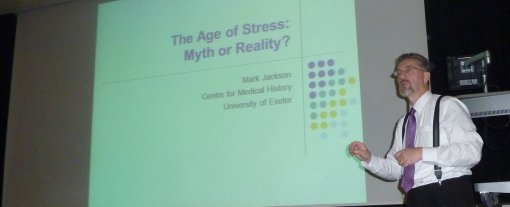
________________________________________________
Congratulations to Stuart Wildman, who had his PhD confirmed at the Winter Graduation Ceremony. He will now begin the work of publishing the findings of his study into provincial nurse training associations in the age of nursing reform. Well done, Stuart!
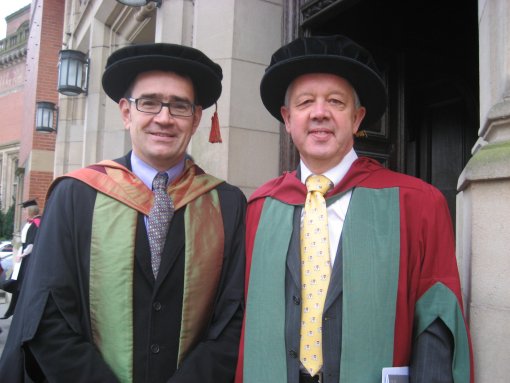
November
The History of Medicine Unit is pleased to announce the launch of the local poppy appeal to Birmingham Mail readers and remind members of the public that the university played a central part in the medical treatment of soldiers in World War One when university buildings, including the Aston Webb building, were organised into the First Southern General Hospital.
Workshops in November:
- Schools workshops in collaboration with the Repertory Theatre, Birmingham, Monday 12th November 2012 - Thursday 22nd November 2012
If your school would like to book a workshop please contact The Repertory Theatre, Birmingham, 0121 236 4455 http://www.birmingham-rep.co.uk/event/wounded
- Wounded by Jenny Stephens, presented at TA Centre, Kings Heath 29 October – 10 November 2012
The battle of Passchendaele, or Third Ypres was emblematic of the futility and senseless butchery of the First World War. Due to an extraordinarily wet summer and the swampy terrain the battle is an illustration of the miseries of fighting in mud, where many soldiers drowned in the shell holes. Approximately 310,000 British men and 260,000 Germans lost their lives at the battle of Passchendaele, in the ‘war to end all wars’.
Julia Hyland, Outreach Officer and Medical Effects Make-up Artist will be presenting a number of workshops based around the play ‘Wounded’. Medical effects make-up will be used to illustrate life in the trenches during World War One. Participants will explore the dreadful effects of Mustard Gas, used for the first time in 1917 by the Germans and which resulted in terrible burns while Dysentery, Trench Foot, Typhus and epidemic disease killed more people than guns or shells where the total number of people killed was over thirty seven million.
October
Jonathan Reinarz has just returned from a 12-day lecture tour in China. His trip took him to academic departments at universities in Nanjing, Hefei and Hangzhou, where he gave 6 lectures on topics in the history of medicine, ranging from an introductory lecture exploring past and current directions in the history of medicine, an exploration into the evolution of the modern hospital, as well as the history of occupational health over three centuries. His lecture at Anhui University attracted considerable attention, as it was the first occasion of a foreign historian visiting the university. The trip was part of a collaboration to develop closer links with the World History Department at Nanjing University, and possibly commence a jointly authored history of the city's first hospital.
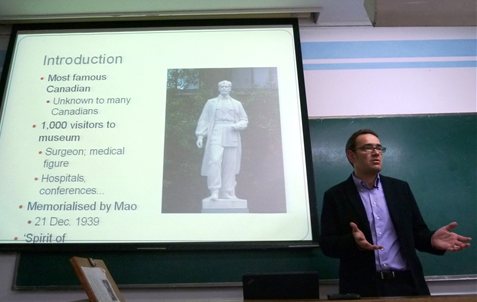
Jonathan at the Institute for Advanced Studies at Nanjing University discussing the life of Canadian surgeon, Norman Bethune, who worked in China between 1938 and his death in November 1939.
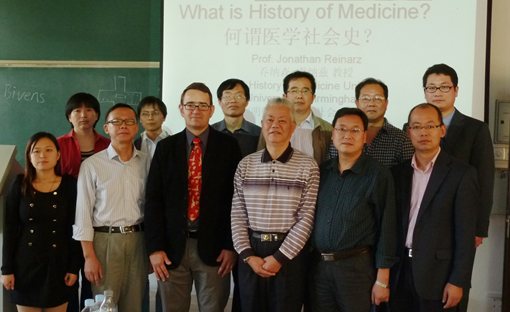
Jonathan with members of the History Department at Anhui University following his introductory lecture on the history of medicine.
September
Congratulations go out to Stuart Wildman, Lecturer in Nursing in Health and Population Sciences and PhD student in the History of Medicine. Stuart successfully passed his viva with minor corrections on 20 September. Stuart’s thesis was on ‘Local Nursing Associations in an Age of Nursing Reform, 1860-1900’, and was examined by Professors Anne-Marie Rafferty (King’s College, London) and Christine Hallett (Manchester). Well done, Stuart!
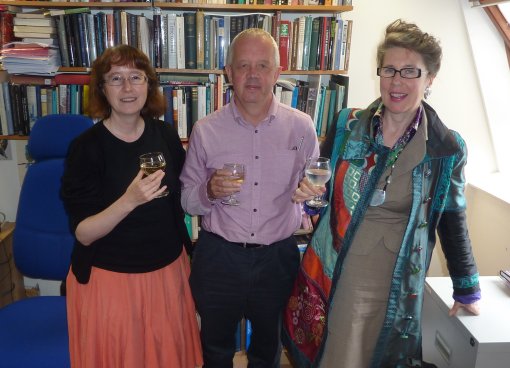
Stuart enjoying the success of all his hard work and a toast by his examiners, Professors Christine Hallett (left) and Anne-Marie Rafferty (right).
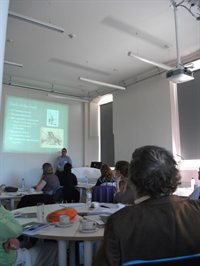 On 7 September, Unit Director Jonathan Reinarz spoke at a conference, entitled 'Local Medicine, Local health, 1700-2011', an event which inaugurated the opening of the new Infirmary Museum at the City Campus of the University of Worcester. On the day, Jonathan spoke about practitioners' use of medical topographies, specifically those related to the west midlands area, in a period predating germ theory in order to catalogue the health risks of particular regions and populations. He also chaired the discussion at the conclusion of a day, which saw a number of academics present their work in this field of research. For those interested in the programme or the museum, please visit the museum's webpage: http://www.medicalmuseum.org.uk/ They also have a page on Facebook.
On 7 September, Unit Director Jonathan Reinarz spoke at a conference, entitled 'Local Medicine, Local health, 1700-2011', an event which inaugurated the opening of the new Infirmary Museum at the City Campus of the University of Worcester. On the day, Jonathan spoke about practitioners' use of medical topographies, specifically those related to the west midlands area, in a period predating germ theory in order to catalogue the health risks of particular regions and populations. He also chaired the discussion at the conclusion of a day, which saw a number of academics present their work in this field of research. For those interested in the programme or the museum, please visit the museum's webpage: http://www.medicalmuseum.org.uk/ They also have a page on Facebook.
August
History of Medicine PhD student, Stuart Wildman presented his research at the 'International Nursing History Conference' in Denmark, August 9-11, 2012. The paper was entitled ‘Female philanthropy and the reform of nursing in provincial England, 1862-1900’, and derives from his thesis, which he will be defending in late September.
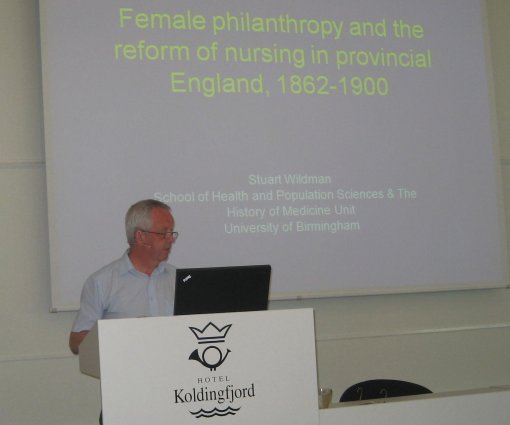
June
Together with the History of Medicine Unit, Dr June Jones, recently managed the repatriation of eight skulls from an American indigenous group in California that were part of the Medical School museum since at least the early twentieth century. June flew with the skulls and returned these to the Salinan tribe in San Luis Obispo County, California.
________________________________________________
Unhealthy Histories with Julia Hyland, Medical Effects Make-up and Outreach Officer, University of Birmingham
Hampton Court Palace, London. Monday 18th June 2012 at 6.30pm – 8pm.
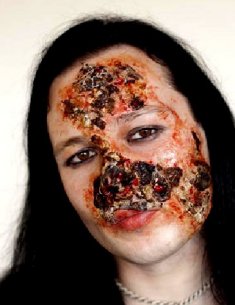 There were two sides to life at the court of Charles II, the glamorous elegance of fashionable court life, alongside the debauched reality of 17th-century behaviour. Throughout these hedonistic times, syphilis was widespread, and its effects devastating. Many who pursued the libertarian lifestyle a little too enthusiastically succumbed to the disease, their reputations destroyed.
There were two sides to life at the court of Charles II, the glamorous elegance of fashionable court life, alongside the debauched reality of 17th-century behaviour. Throughout these hedonistic times, syphilis was widespread, and its effects devastating. Many who pursued the libertarian lifestyle a little too enthusiastically succumbed to the disease, their reputations destroyed.
Join Julia Hyland as she discusses this disease, its place in 17th-century history, its treatment and the stigma associated with it. Julia will bring the history of this disease to life through medical effects make-up. This visual presentation with audience participation will reveal how applying medical effects make up to a healthy individual can help them empathise physically and emotionally with the diseases of the past and stimulate debate into medical history and treatments.
Pepys wrote in his diary in March 1664 that his brother fell ill of the pox, and lamented that “if he lives, he will not be able to show his head – which will be a very great shame to me.”¹
1. A. Wear ‘Medicine in Early Modern Europe, 1500-1700’, in L. Conrad, V. Nutton, R. Porter and A. Wear (eds), The Western Medical Tradition, 800 BC to AD 1800 (2000) 215–362, 262.
May
Jonathan Reinarz attended the Annual Conference of the Royal College of Paediatrics in Glasgow on 23 May. Jonathan was this year’s George Armstrong Lecturer and delivered a keynote address entitled ‘Locating the Child: the health care of children in Victorian and Edwardian Britain’.
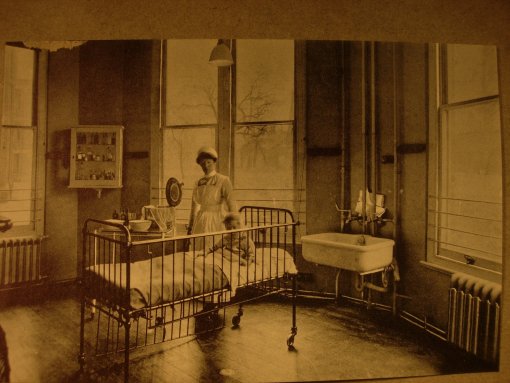
A ward on the Children's Hospital, Birmingham, c. 1920s.
April
Jonathan Reinarz attended the American Association for the History of Medicine annual conference in Baltimore in April, where he presented a paper on the emergence of the laboratory at English provincial medical schools between 1830 and 1920. The conference is the biggest annual medical history event in North America and, besides the usual academic meetings, involved a tour of the new buildings at Johns Hopkins Medical School and a very enjoyable reception at the University’s History of Public Health Unit.
March
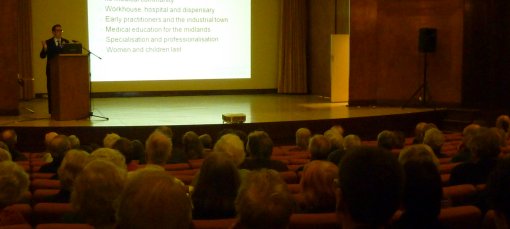 History of Medicine Unit Director Jonathan Reinarz gave one of this year’s National Trust Lectures at the Barber Institute of Fine Arts on 13 March. The theme of this year’s lecture series was inspired by Octavia Hill, social reformer and co-founder of the National Trust. As part of the series, which focused on the history of charity, Jonathan gave a talk on the medical charities of Birmingham in the eighteenth and nineteenth centuries. Entitled ‘Health Care in the Heart of England’, the lecture was attended by well over 100 members of the public.
History of Medicine Unit Director Jonathan Reinarz gave one of this year’s National Trust Lectures at the Barber Institute of Fine Arts on 13 March. The theme of this year’s lecture series was inspired by Octavia Hill, social reformer and co-founder of the National Trust. As part of the series, which focused on the history of charity, Jonathan gave a talk on the medical charities of Birmingham in the eighteenth and nineteenth centuries. Entitled ‘Health Care in the Heart of England’, the lecture was attended by well over 100 members of the public.
_________________________________________________
Following on from the success of last year’s ‘Boils Are Us’ event at Oxford Brookes, Julia has been exploring the gory history of plagues and disease in ‘Boils Are Us – reloaded’ at Oxford Brookes’ Science Bazarre
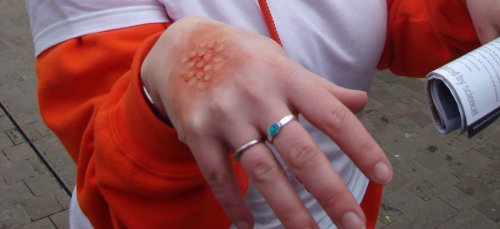
January
On Friday, 20 January, Unit Director Jonathan Reinarz travelled to Worcester and was given a tour of the new site of the George Marshall Medical Museum in the former hospital on Castle Street which is now part of University of Worcester’s City Campus.
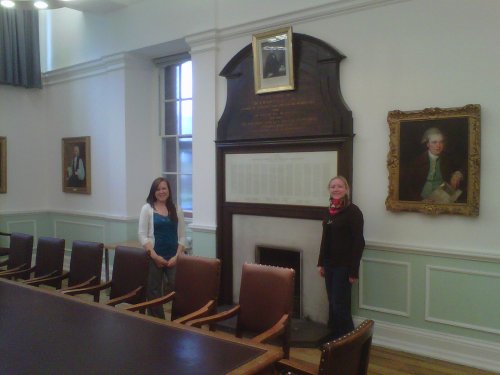
Catriona (left) and Claire (right) in what was originally known as the Physicians’ Room, but later became the hospital’s Board Room and was the location in 1832 for the inaugural meeting of what subsequently became the British Medical Association.
Together with Museum Curator/Manager Catriona Smellie and Researcher Claire Jones, Jonathan now sits on the Museum Sub-committee. While in Worcester, Jonathan also visited a building on Silver Street that housed the original eighteenth-century infirmary, which now being redeveloped as part of a retail site in the city centre. Guided by Carl Jukes, Conservation Officer for Worcester City Council, Jonathan was shown some of the buildings more interesting features, including some early graffiti

For more information on the hospital’s history and the larger museum project
The Infirmary Museum project is on Facebook. Follow them at https://www.facebook.com/pages/The-Infirmary-Worcester-UK/145220818904443?ref=ts